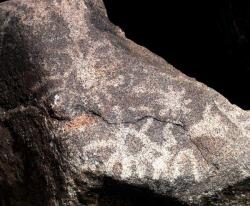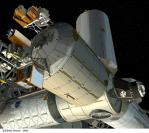The asteroid 2004 XP14 is expected to approach Earth on July 3. Though not exactly a doomsday scenario, the half-mile diameter rock will flyby at a distance of roughly 268 thousand miles, a hairpin in astronomical terms.
The Apollo-class asteroid (which means it has an Earth-crossing orbit), was discovered on December 10, 2004, and is classified as a Potentially Hazardous Asteroid. It will be closest to the earth at 4:25 UT on Monday.
semimajor axis = 1.032 AU
eccentricity = 0.162
inclination = 32.5°
perihelion = 0.865 AU
aphelion = 1.199 AU
More on Near-Earth Objects here
Wednesday, June 28, 2006
Monday, June 26, 2006
Hubble Camera Fails
 Hubble Space Telescope's Advanced Camera for Surveys failed last week. The ACS, installed in 2002, reportedly had problems with its power supply and was shut down last Monday. NASA engineering are currently looking into the problem and how to repair the camera.
Hubble Space Telescope's Advanced Camera for Surveys failed last week. The ACS, installed in 2002, reportedly had problems with its power supply and was shut down last Monday. NASA engineering are currently looking into the problem and how to repair the camera.The HST main site is here
Thursday, June 22, 2006
Meet Nix and Hydra
 Newly Discovered Moons of Pluto Named
Newly Discovered Moons of Pluto NamedThe International Astronomical Union named the two newly discovered moons of Pluto - Nix and Hydra. The moons, spotted by the Hubble Space Telescope and discovered by astronomers led by Alan Stern in 2005, are named after Greek myth characters. Nix is the goddess of darkness and Hydra is the many-headed monster in the underworld.
Now, if only the IAU can make up its mind on whether Pluto is a planet...
Photo credit: NASA
Thursday, June 15, 2006
Quote, Unquote: Calvin
 "Sometimes I think the surest sign that intelligent life exists elsewhere in the universe is that none of it has tried to contact us."
"Sometimes I think the surest sign that intelligent life exists elsewhere in the universe is that none of it has tried to contact us."Calvin of Calvin and Hobbes, by Bill Watterson
Wednesday, June 14, 2006
Quote, Unquote: Stephen Hawking
 "It is important for the human race to spread out into space for the survival of the species. Life on Earth is at the ever-increasing risk of being wiped out by a disaster, such as sudden global warming, nuclear war, a genetically engineered virus or other dangers we have not yet thought of."
"It is important for the human race to spread out into space for the survival of the species. Life on Earth is at the ever-increasing risk of being wiped out by a disaster, such as sudden global warming, nuclear war, a genetically engineered virus or other dangers we have not yet thought of."- Stephen Hawking, quoted in a news conference held at the Hong Kong University of Science and Technology, on June 13, 2006. He will give a lecture there on June 15.
Why Genesis Crashed
 NASA has released a report discussing the demise of the Genesis space probe. A set of gravity switches installed backwards did the space probe in as it re-entered the earth's atmosphere on September 8, 2004. Genesis was designed to collect solar wind atoms and return the samples back to earth after a 3-year mission. Because of the flawed switches, the Genesis crash landed on its re-entry. The container housing the samples cracked thereby exposing its payload to contamination.
NASA has released a report discussing the demise of the Genesis space probe. A set of gravity switches installed backwards did the space probe in as it re-entered the earth's atmosphere on September 8, 2004. Genesis was designed to collect solar wind atoms and return the samples back to earth after a 3-year mission. Because of the flawed switches, the Genesis crash landed on its re-entry. The container housing the samples cracked thereby exposing its payload to contamination.The Genesis was launched on August 8, 2001 and began collecting samples on December of that year.
Photo credit: Caltech/NASA
Tuesday, June 13, 2006
Brit Robot for Mars
 British scientists have unveiled "Bridget," the autonomous robotic craft designed to explore Mars. Its designers are hoping that the robot will be included in the European Space Agency's ExoMars mission to be launched in 2011.
British scientists have unveiled "Bridget," the autonomous robotic craft designed to explore Mars. Its designers are hoping that the robot will be included in the European Space Agency's ExoMars mission to be launched in 2011.The 150-kg autonomous vehicle is expected to go further than NASA's Sojourner or Spirit robots, and will cost up to 150 million euros.
More here
Monday, June 12, 2006
Google Earth's Birthday
 Today is Google Earth's first birthday. Google Earth is the fine virtual globe program downloadable free from Google that has sent shivers to dictators and military men everywhere for its hi-res imagery of the earth's surface. I once used the software to locate the airfield of the famed Area 51 in Nevada, and a site even sponsors a contest to locate black helicopters (ostensibly the ones used in covert ops). The same site even reported that al Qaeda uses the software to stalk its targets.
Today is Google Earth's first birthday. Google Earth is the fine virtual globe program downloadable free from Google that has sent shivers to dictators and military men everywhere for its hi-res imagery of the earth's surface. I once used the software to locate the airfield of the famed Area 51 in Nevada, and a site even sponsors a contest to locate black helicopters (ostensibly the ones used in covert ops). The same site even reported that al Qaeda uses the software to stalk its targets.With the new version, Google Earth 4, the software now runs on OS X and Linux, aside from its Windows flavor. Resolution was also improved, from 15 meters per pixel to 70 cm/pixel (some countries can be viewed at an amazing 10 cm per pixel). At this resolution you can well see Kim Jong Il's rump as he moons SoKor troops over the DMZ.
Friday, June 09, 2006
Lucy in the skies with diamonds
 It has been reported that astronomers using data from Far Ultraviolet Spectroscopic Explorer, or FUSE, have deduced that planets may be orbiting the star Beta Pictoris, around 60 ly away from us. Beta Pictoris is said to be teeming with carbon, as such, the planets around it may have encrusted with diamonds as large as boulders.The planetary system and Beta Pictoris itself are relatively young, around 20 million years old.
It has been reported that astronomers using data from Far Ultraviolet Spectroscopic Explorer, or FUSE, have deduced that planets may be orbiting the star Beta Pictoris, around 60 ly away from us. Beta Pictoris is said to be teeming with carbon, as such, the planets around it may have encrusted with diamonds as large as boulders.The planetary system and Beta Pictoris itself are relatively young, around 20 million years old.I won't be surprised if they name the planets Lucy, deBeers, and Tiffany.
More from NASA here and here.
Tuesday, June 06, 2006
Ancient record of supernova explosion?
 John Barentine of Apache Point Obsevatory is suggesting that ancient Native Americans may have recorded a supernova explosion in AD 1066. The purported record is carved in a rock found in Arizona. The petroglyph apparently shows an eight-pointed star and a scorpio, which according to Barentine, could be the supernova explosion that occured at the vicinity of Scorpius more than a millenia ago.
John Barentine of Apache Point Obsevatory is suggesting that ancient Native Americans may have recorded a supernova explosion in AD 1066. The purported record is carved in a rock found in Arizona. The petroglyph apparently shows an eight-pointed star and a scorpio, which according to Barentine, could be the supernova explosion that occured at the vicinity of Scorpius more than a millenia ago.Comments:
It could be a possibility, but it is not conclusive, as Barentine himself conceded. It is not clear whether ancient Native Americans see the constellation Scorpio as indeed something that looks like a scorpio, so the representation could be just coincidental. Who knows, maybe it was just a kid drawing a flower beside a scorpion?
Apache Point Observatory website is here.
Photo by John Barantine/Apache Point Observatory
Friday, June 02, 2006
Russian Star Power
 Power cells that harness starlight
Power cells that harness starlightScientists from the Dubna Nuclear Institute of Russia announced recently that they have developed a new kind of battery that can harness electricity not just from the sun but from star light as well. The new battery is said to be cheaper than solar panels and can function 24 hours a day.
(Through physorg.com)
Thursday, June 01, 2006
Cellphone for Astronomers
 Sharp 904SH mobile phone
Sharp 904SH mobile phoneThe Sharp 904SH is a cellphone perfect for amateur astronomers. The mobile phone is equipped with a 3D motion sensor ans specialized software called Seiza o Sagaso, which means "let's look for constellation." By pointing the cellphone towards the sky, the sensor and the software will display the stars and constellation that you can see from your location.
The 904Sh also comes with other nifty features that will appeal to geeks everywhere: VGA screen, 3.2 megapixel camera, a face recognition system (that can shut down the phone when it senses it's not the owner who is using the phone), Bluetooth connectivity, mini-SD memory expansion and standby time of 360 hours.
Full review here.
Global Warming makes Nastier Poison Ivy
 If floods caused by global warming won't be enough to kill you, then maybe nasty welts from poison ivy will do the trick. It seems that the increased levels of carbon dioxide the in the atmosphere will produce more itchier vines. This is the conclusion of the study made by scientists from Duke University. The higher concentration of CO2, according to the scientists, makes the poison ivy produce more uroshiol, the compound that causes rashes.
If floods caused by global warming won't be enough to kill you, then maybe nasty welts from poison ivy will do the trick. It seems that the increased levels of carbon dioxide the in the atmosphere will produce more itchier vines. This is the conclusion of the study made by scientists from Duke University. The higher concentration of CO2, according to the scientists, makes the poison ivy produce more uroshiol, the compound that causes rashes.
Columbus Arrives in the US
 No, Cristobal Colon did not turn up from his grave to visit the continent he discovered. Rather, the Columbus laboratory, Europe's contribution to the International Space Station, is now in the US. The billion-euro, 20-ton module, which will house scientific equipment, will be launched to space and mated to the ISS next year.
No, Cristobal Colon did not turn up from his grave to visit the continent he discovered. Rather, the Columbus laboratory, Europe's contribution to the International Space Station, is now in the US. The billion-euro, 20-ton module, which will house scientific equipment, will be launched to space and mated to the ISS next year.Built since the mid-1990s, the Columbus science module was stalled because of the delays in the construction of the space station, as well as by the Columbia Space Shuttle disaster.
The European Space Agency website is here.
Photo from ESA
Subscribe to:
Posts (Atom)